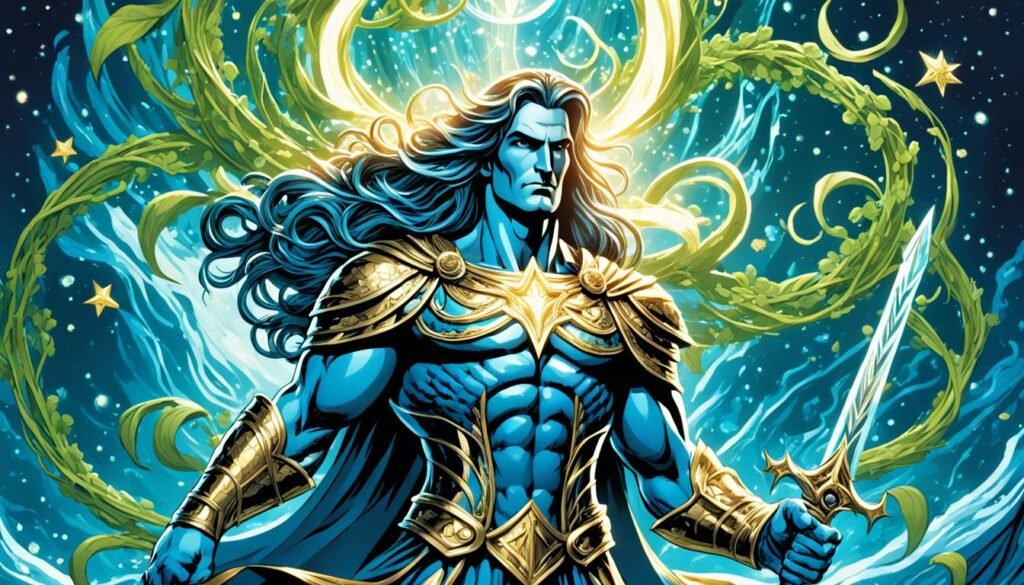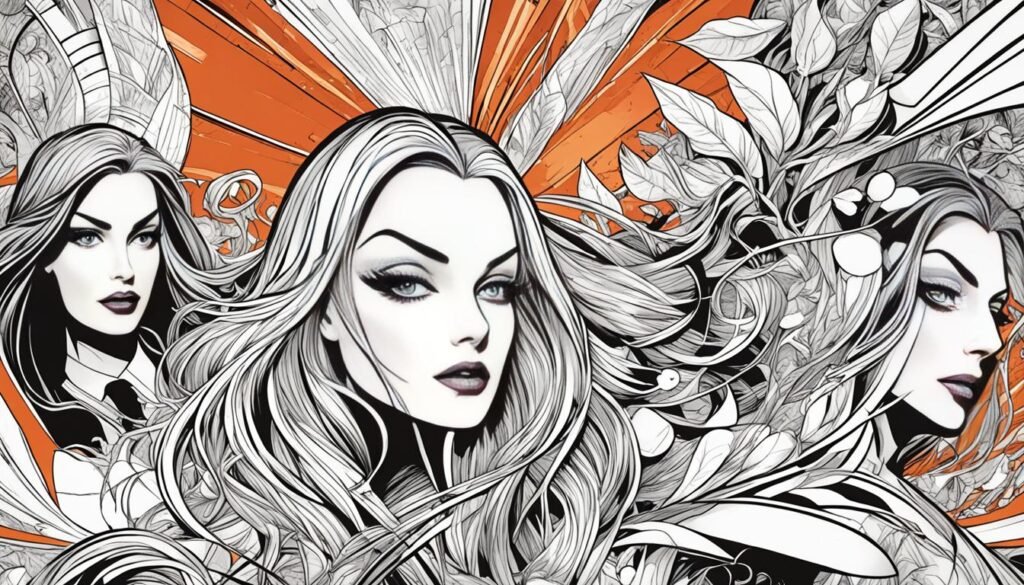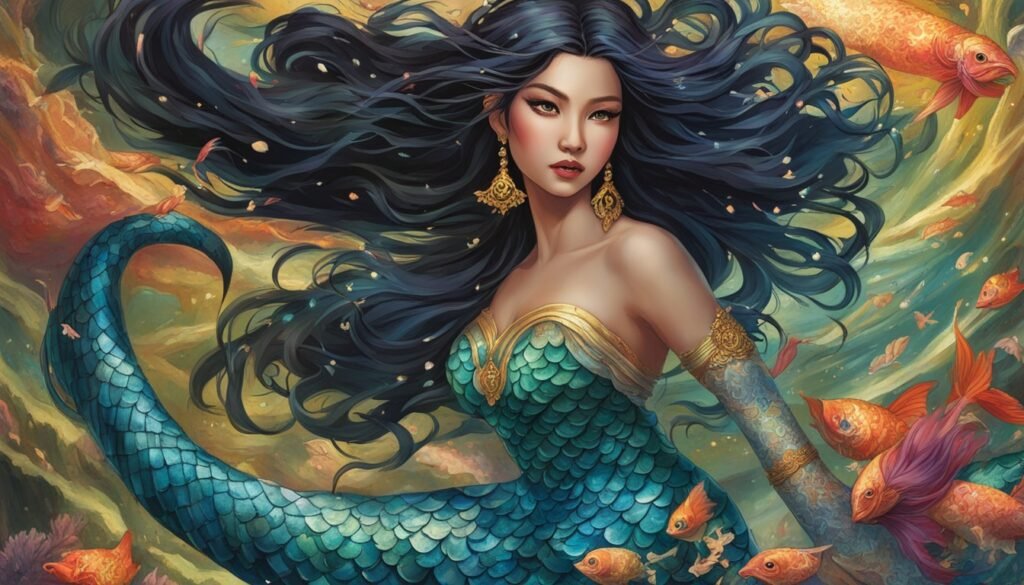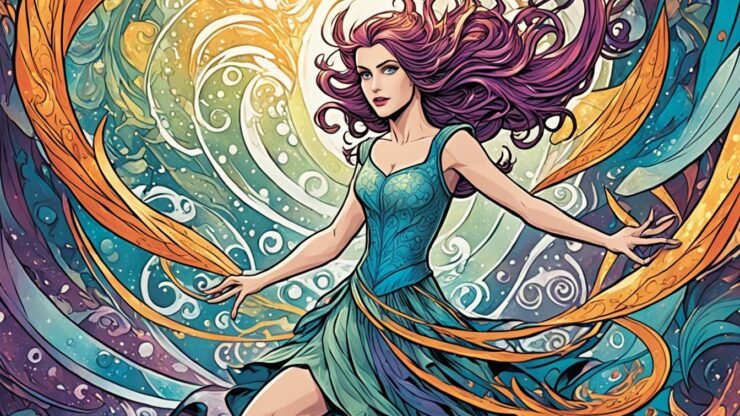As the sun set, a bright glow lit the waves. A beautiful, yet eerie, song drifted across the water. The fishermen, listening, couldn’t help but follow the siren call of the Magindara. These mythical beings from Filipino stories are known for their enchanting voices and clever tricks. They’ve captivated and frightened the people for years.
The Magindara are described as stunning women with fish tails. They’re believed to either guard the sea or be dangerous sea monsters. Legends about them have been shared for ages, creating an air of mystery and allure.
This article will explore the Magindara’s background, traits, and importance in Filipino culture. From their captivating songs to their smart ways, these is creatures have made an unforgettable impact on the country’s myths.
Key Takeaways
- Magindara are captivating mythical creatures from Filipino folklore known for their alluring voices and deceptive tactics.
- They are depicted as beautiful maidens with fish-like tails who can lure unsuspecting fishermen to their demise.
- The Magindara’s reputation as both guardians and vicious “aswang ng dagat” (sea monsters) has intrigued and terrified Filipinos for generations.
- This article will explore the origins, attributes, and cultural significance of these enigmatic beings.
- The Magindara’s enchanting nature and the mysteries surrounding them have been woven into the rich tapestry of Philippine mythology.
Unveiling the Enchanting Realm of Magindara
The Magindara are mythical creatures from Philippine mythology. They live in the seas and waterways, mainly in the Bicol region. These fascinating beings have mesmerized Filipinos with their beautiful looks, haunting songs, and the secrets of their world. Stories and myths about the Magindara have been shared for many years, creating a world of mystery and wonder.
The charm of the Magindara goes beyond their looks. It is said they can enchant and lure people with their amazing voices. They are a big part of Philippine tales and legends. In this way, they are deeply woven into the cultural history of the region.
| Mythical Creature | Attributes |
|---|---|
| Magindara | Beautiful maidens with fish-like tails, known for their captivating voices and alluring appearance |
| Buringcantada | A giant with one eye in the middle of his forehead and two long tusks projecting from his mouth |
| Laki | A creature in Bicol mythology with an upper body |
The world of the Magindara still captures the hearts of Filipinos today. Their tales and images are key parts of the rich mythology of the Philippines. From their beginnings in Bikolano folklore, the Magindara are a powerful symbol of the magic in Philippine myths.
Origins and Mythology of the Magindara
The fascinating Magindara are from Philippine myths, deeply rooted in the Bikolano myths and legends. These mysterious beings have always intrigued the Filipino people. Some tales speak of them as protectors of Bikolano fishermen. On the other hand, some say they are dangerous sea monsters called “aswang ng dagat” that eat people they trick into the water.
Bikolano Myths and Legends
The Magindara play a big role in the Bicol region’s cultural history. Stories of their magical and sometimes dangerous adventures are common. They are strongly connected to the sea life in the Philippines. Their legends show the close link between the human world and the sea’s powers.
Guardians or Aswang ng Dagat?
In Bikolano myths, the Magindara are seen as good protectors of Bikolano fishermen or evil sea monsters. This mix of good and bad makes these Magindara figures very intriguing and somewhat scary in Philippine culture.
The Ibalon Connection
In the Ibalon, a legendary poem from the Bicol region, there are brief mentions of the Magindara. These mentions provide valuable details about the Magindara such as their shiny, colorful scales and mesmerizing voices. These features show how the Magindara can be both helpful and dangerous to fishermen. This adds to the ongoing interest in the Philippine mythical creatures.

Physical Attributes of the Magindara
The Magindara are mystical beings from Filipino stories. They look beautiful, like a mix of humans and sea creatures. Their beauty and unique looks make them powerful and enchanting to people.
Captivating Beauty
The Magindara are known for their enchanting looks. They have the upper bodies of beautiful maidens. These features are so alluring that anyone who sees them is captivated.
With long, flowing hair and alluring faces, the Magindara have an enchanting presence. They attract others with an almost magnetic force.
Colorful Scales and Fish-like Tails
Adding to their beauty are their fish-like tails. These tails are bright and shiny, just like a fish’s. They make the Magindara even more captivating with their aquatic charm.
This mix of beautiful human parts and sea features is what makes the Magindara special. They are truly remarkable mythical beings.
The Alluring Voices of the Magindara
The magical power of the Magindara comes from their bewitching voices. Legend says they can sing songs that enchant anyone who listens. These songs lead people, like fishermen, into the sea unwittingly.
The Magindara’s voices are like magic, able to mesmerize anyone. They are so enchanting that whoever hears them wants to follow the sound into the sea. Those lured are never seen again. This allure makes them both attractive and perilous to those who hear their songs.
The Magindara songs have traveled through time in Filipino tales. They keep the mystery alive around these mythical beings. Their voices play a big role in why people are still interested in these mysterious sea folk today.

Magindara: Deception and Luring Tactics
Luring Fishermen to Their Demise
The Magindara are captivating but deadly creatures from Philippine folklore. They use their beauty and alluring voices to trick fishermen. Once in the sea, these fishermen meet a tragic end, drowned and eaten. The mermaids’ songs are mesmerizing, leading their victims to a watery grave.
The Paradox: Sparing Children
Despite their danger, the Magindara have a strange rule. They spare children, finding them harmful in some way. This protection shows a different side to these sea sirens. It makes us wonder about their choices and the power of innocence against evil.
Magindara in Philippine Folklore and Art
The captivating Magindara are mythical creatures from Filipino folklore. They have enchanted storytellers for generations. Their allure has inspired a wide range of writings and artistic works. Everyone from ancient epic poets to modern artists has been drawn to the Magindara’s fascinating and mysterious nature.
Literary Representations
Their first literary appearance was in the Ibalon, an ancient epic from the Bicol region. This epic poem mentions these sea creatures as both beautiful and deadly. They were described as having colorful, sharp scales and voices that lure fishermen. This work set the stage for the Magindara’s exploration in literature.
Since then, the Magindara have appeared in many literary pieces. Whether in the Philippines or abroad, authors have incorporated these beings in their stories. They explore the creatures’ origins, their ties to humans, and how beliefs about them have changed over time.
Visual Interpretations
The Magindara also shine in visual art. Illustrations and paintings capture their beauty and mysterious charm. These artworks have become an integral part of Philippine art, showcasing the Magindara’s place in the people’s hearts.
Emirajuju and Mykie Concepcion are celebrated for their watercolor paintings of the Magindara. They beautifully depict the mythical beings. Their work helps ensure the Magindara’s culture continues to inspire others.

Thanks to literature and art, the Magindara are firmly rooted in Philippine culture. Their stories and images continue to be cherished. They stand as a symbol of the enduring appeal of Filipino cultural heritage and the fascination with the natural world.
The Magindara Connection to Other Mythical Beings
The Magindara are linked to many other mythical beings in the Philippines. In the Bikolano culture, they are seen as daughters of the mysterious Asuang. They have a sister, Oryol, who is famous in local folklore.
The Deity Asuang and Oryol
The Asuang connects closely with the Magindara. Some stories say the Magindara are Asuang’s children. They got their beauty and powers from their parent. Oryol, their sister, is also a key figure in Philippine myths.
The Moon God Bulan
The Magindara are significant beyond their family ties. They are related to the moon god, Bulan. They were supposed to catch him but fell in love with his beauty instead. This story shows their key role in Filipino mythology.
Cultural Significance and Symbolism
The Magindara are deeply important in the Philippines. They stand for sea guardians and nature’s mighty power. They are seen as guardians of the waters, keeping Filipino fishermen safe.
As protectors, they highlight the balance between us and nature’s might.
Guardians of the Sea
In myths from Bicolano and Visayan regions, the Magindara lovingly watch over the sea. They guide Filipino fishermen and ensure their safe journey. This image as guardians has made them key to Philippine culture.
Embodiment of Nature’s Power
The Magindara represent the wild strength of nature. Their beauty and danger show us the force of nature. They call for our deep respect and remind us of nature’s fine balance.

Preserving the Magindara Legacy
The stories of the Magindara are loved by many in the Philippines. People are working hard to keep this cultural heritage alive. They do this by writing down tales, sharing through books, and showing them in art. This way, the Magindara’s legacy stays bright for the future.
Across the country, groups have joined to spread the word about the Magindara. They publish stories, make educational stuff, and hold fun events. These efforts teach more people about the Magindara, bringing their legacy to life again.
Art and literature today often include Magindara themes. This keeps the Magindara’s presence strong in the Philippines. The merging of old tales with modern life helps keep their legacy alive for the next generations.
The Magindara stories are powerful and continue to inspire today. Many people, from scholars to artists, are working together. They want to make sure the Magindara’s legacy lasts forever. By their work, the Magindara remain an important part of Philippine mythology.
Conclusion
The Magindara are a key part of Philippine mythology. They bring together beauty, special voices, and a complex story. They are part of the fascinating world of the Philippines. These mythical creatures are seen as guardians of the sea and the power of nature. They have a lasting impact on the people of the Philippines.
Their stories and images are kept alive. This helps keep the Magindara alive in future minds. Even today, people report seeing mermaids. The Magindara are at the heart of these stories, drawing interest from people all over the world. This shows their strong place in the wide collection of Philippine folklore and legend.
The legends of the Magindara show the lasting strength of myths and the imagination. They highlight the mystery and interest in what we don’t fully understand, especially under the sea. The mermaid stories are explored over and over again. The Magindara are a key, loved part of Philippine mythology.
FAQ
What are the Magindara?
Where do the Magindara inhabit?
What are the origins of the Magindara?
How are the Magindara described physically?
What is the key aspect of the Magindara’s legendary power?
What are the Magindara’s deceptive and treacherous tactics?
How are the Magindara represented in Philippine folklore and art?
How are the Magindara connected to other legendary figures and deities?
What is the cultural significance of the Magindara?
How is the legacy of the Magindara being preserved?
Source Links
- https://encantadiasaga.fandom.com/wiki/Magindara
- https://bicolanomythsofgodsandmonsters.blogspot.com/2018/03/
- https://www.aswangproject.com/magindara/
- https://en.wikipedia.org/wiki/List_of_Philippine_mythological_creatures
- https://en.wikipedia.org/wiki/Sirena_(Philippine_mythology)
- http://bicolanomythsofgodsandmonsters.blogspot.com/2017/01/magindara.html
- https://gspot.ph/culture/5-filipino-mythological-creatures-you-may-not-know-about/
- https://en.wikipedia.org/wiki/Mermaid

